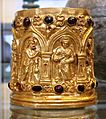Hamsa (bird) facts for kids

The Hamsa (pronounced hum-sah) is a special aquatic bird often mentioned in old Sanskrit writings. Experts believe it could be a goose, a swan, or even a flamingo. This bird is a spiritual symbol and a beautiful decoration in Indian and Southeast Asian cultures.
People also use the Hamsa as a metaphor. It's said to have a magical ability to separate milk from water, or good from evil. In Hinduism, the Hamsa is the vahana (or vehicle) for important gods and goddesses like Brahma, Gayatri, Saraswati, and Vishvakarma.
Contents
What is the Hamsa?
A language expert named Monier Williams explained that the Sanskrit word "Hamsa" means "a goose, gander, swan, flamingo (or other water bird that travels long distances)." It also refers to a mythical bird known for its wisdom.
In ancient Indian texts like the Rig Veda, the Hamsa is a bird that can separate a special drink called Soma from water. Later stories say it can separate milk from water. In Indian philosophy, the Hamsa often stands for the individual soul or spirit. It's seen as pure and white, like a goose or swan. It can also represent the "Universal Soul" or "Supreme Spirit."
The word Hamsa is similar to words for "goose" in many other languages. For example, it's like "goose" in English, "Gans" in German, and "ganso" in Spanish.
The Hamsa in Hinduism
In Hinduism, the Hamsa is often connected to the Supreme Spirit, which is called Brahman. The flight of the Hamsa symbolizes moksha. This means freedom from the cycle of birth, death, and rebirth, known as samsara.
The Hamsa is also the animal that carries several gods and goddesses. It is the vahana of Saraswati, who is the goddess of knowledge and art. It also carries Brahma, the god of creation, and Gayatri, the goddess of the Vedas.
What is a Paramahamsa?
Because the Hamsa has so many special meanings, Hindu wise people called rishis (sages) and sadhus (holy people) are sometimes given the title paramahamsa. This means "supreme hamsa." It shows that a person has reached a very high level of spiritual understanding.
For example, an old text called the Paramahamsa Upanishad describes a Paramahamsa as a wise person who is not easily upset by criticism. They are not jealous or boastful. They are humble and don't care about human weaknesses. They are so focused on spiritual truth that they treat their own body like it's just a shell. They live knowing the ultimate truth, Brahman.
Hamsa in Indian Stories
Hamsa, or hansa, birds appear in many Indian stories. Arayanna, which are heavenly Hamsas, are said to live in a mythical lake called Manasasaras in the Himalayas. They are mentioned in the famous Hindu epic, the Ramayana. The Hamsa also plays a role in the love story of Nala and Damayanti. In this tale, the Hamsa carries messages and stories between the two lovers.
In Indian texts, the Hamsa is said to eat pearls and separate milk from water. This idea of the Hamsa being able to separate or choose is often used as a metaphor in poetry. One idea is that "milk" might refer to the sap from lotus stems. Another thought is that birds like swans and geese have special filters in their mouths. These filters help them strain food from water. So, the stories might be talking about the bird's natural ability to find the good parts in a mixture.
The Hamsa in Buddhism
The Hamsa was also widely used in the art of Gandhara, an ancient region. It appeared alongside images of the Shakyamuni Buddha. Some experts translate the Hamsa in this context as a swan, while others call it a goose. A 2nd-century BCE Gandharan artwork shows a swan with a rider. This piece is now in the Metropolitan Museum of Art in New York.
The Hamsa is considered sacred in Buddhism and is a symbol of wisdom. In old Nepalese art, Hamsas are drawn as swan-like or goose-like birds. In old Tibetan artwork, they look more like geese. This probably reflects the Indian region where Tibetan monks learned their art.
Hamsa in Modern Times
The name Hamsa is important in many cultures today. In Hindi, it's hans. In Telugu, it's hamsa. In Tamil, it's Aṉṉappaṟavai. In Burmese art, the hintha (which is like the Hamsa) is very common. It's often seen as a ruddy shelduck in Burmese culture. It has also become a symbol for the Mon people. In some parts of Myanmar, the hintha looks more like a hen than a duck. This shows how local animals influence the art.
Gallery
-
Hamsa talking to Damayanti as painted by Raja Ravi Varma (19th century)
See also
 In Spanish: Hamsa para niños
In Spanish: Hamsa para niños







